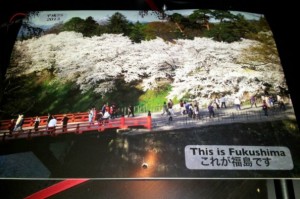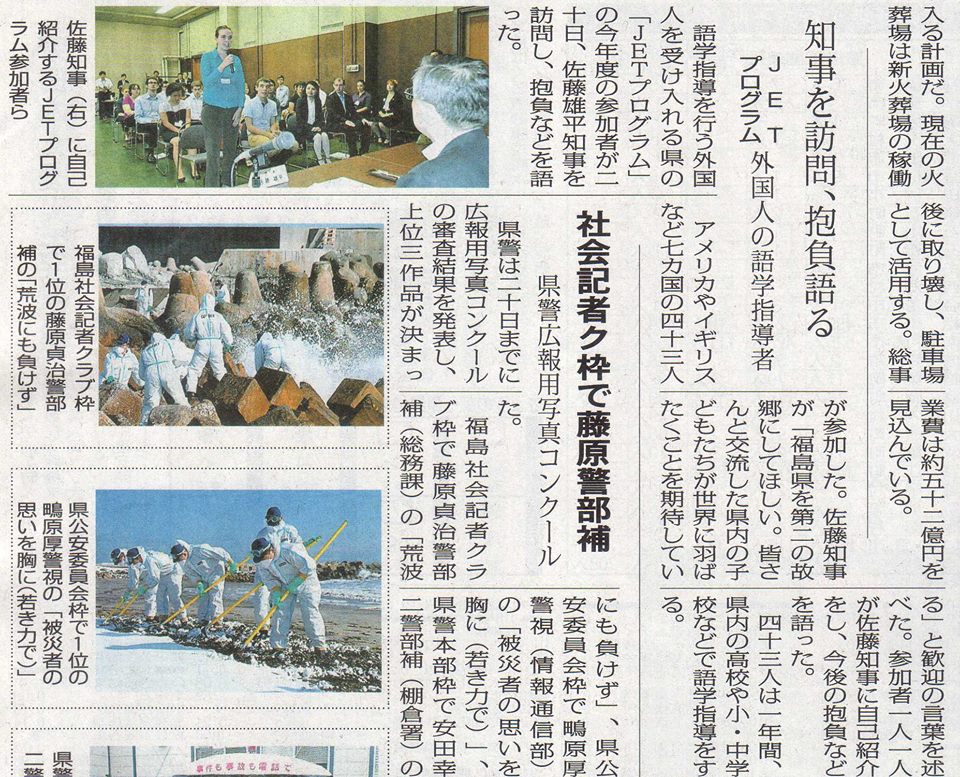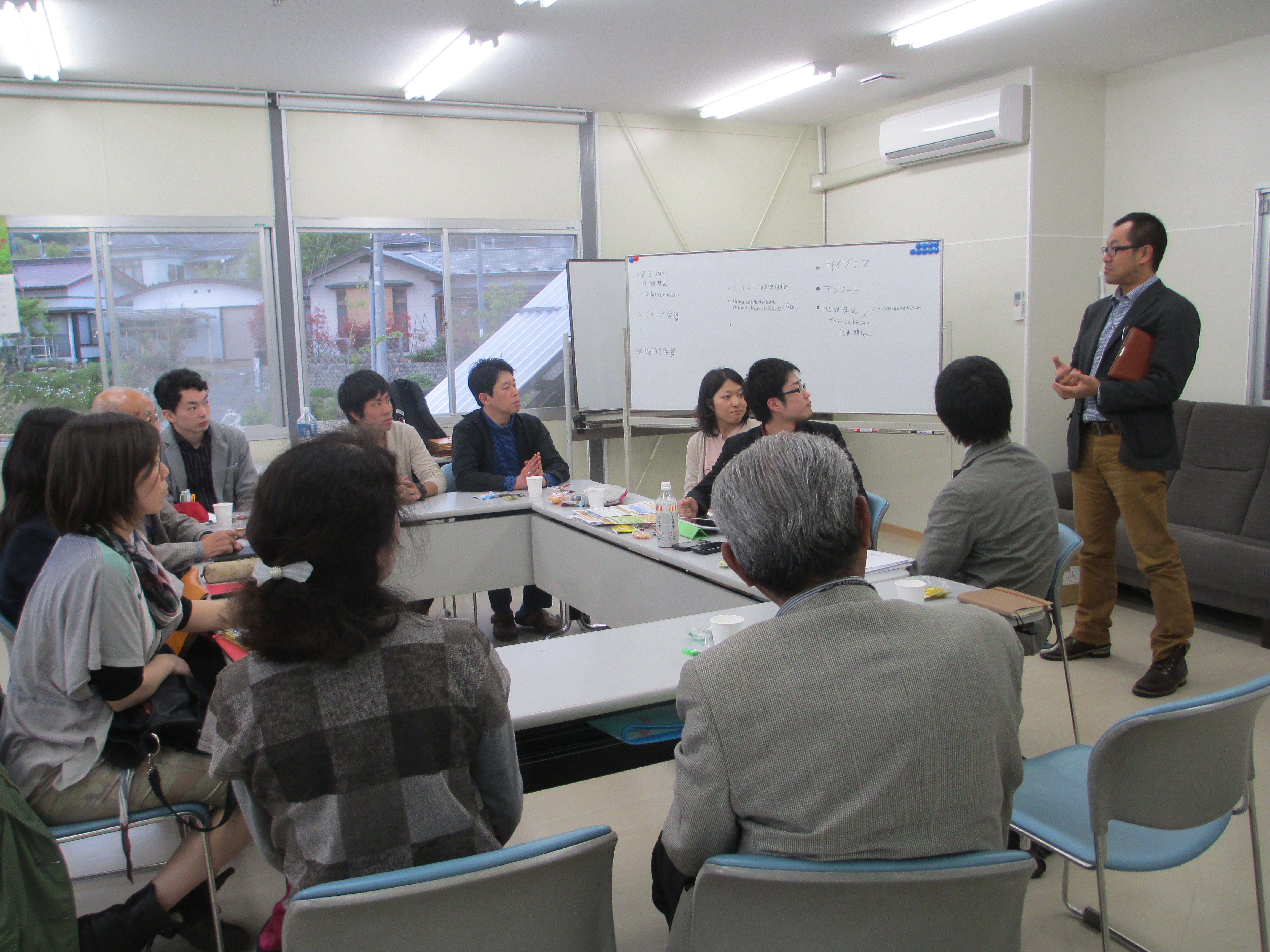Kyodo News “Rural JET alumni” series: Daneeta Loretta Jackson (Fukuoka)
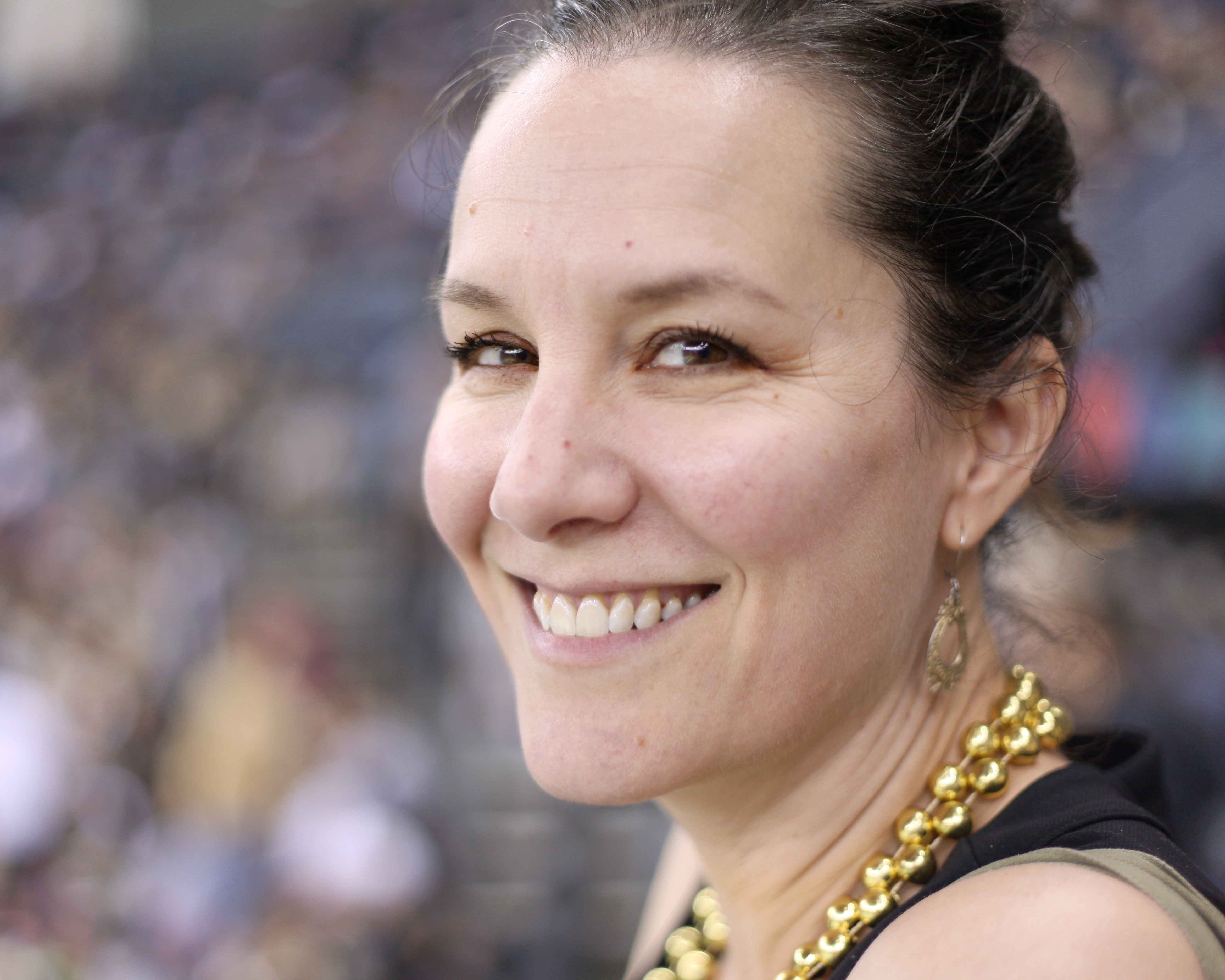
“My JET programme experience and my seven years in Japan have had a profound influence on me. It changed me into a more peaceful, communal person.”
News agency Kyodo News has recently been publishing monthly articles written by JET alumni who were appointed in rural areas of Japan, as part of promotion for the JET Programme. Below is the English version of the column from September 2013. Posted by Celine Castex (Chiba-ken, 2006-11), currently programme coordinator at CLAIR Tokyo.
********
Daneeta Loretta Jackson (Fukuoka-ken, Buzen-shi, 1993-95) was born and raised in the backwaters of Southeast Louisiana. She was educated at public school where she discovered her love for storytelling. She holds a B.A. in English from Loyola University of the South, an M.A. in English from George Mason University, and an M.A. in the Art and Technique of Filmmaking from the London Film School. Her hobbies are international travel, watching movies, anything having to do with dogs, and sleeping. She works as a writer and filmmaker and is a Creative Producer at the ElekTrik Zoo, an arts partnership she co-founded with her husband, Patrick Jackson. She joined the JET programme in 1993 because she wanted adventure. It had a profound affect on her and changed the course of her life.
I was a JET Programme participant from 1993 to 1995 in Buzen-shi, Fukuoka-ken. I never expected to go to Japan. I never dreamed about it when I was a child like so many of my counterparts did. I don’t mean to sound flippant, but the JET Programme for me was a kind of accident. It is too long of a story to recount here. In short, my husband applied for the both of us. He requested a rural post in Fukuoka-ken because a boy from his Japanese baseball team in California was from Fukuoka. When he got word we had been accepted, he told me we were going to Japan. I had about two months to prepare.
Before I knew it, I was on a plane to Tokyo in July of 1993. The first few days were a whirlwind. The orientation in Tokyo and the jet lag made it seem like I was in some sort of dream. I had no idea what awaited me in the countryside, I couldn’t speak much Japanese, and everything seems so strange… so different from my native Louisiana. Read More
CIR continues Fukushima Live blog: Stories from people living in Fukushima prefecture
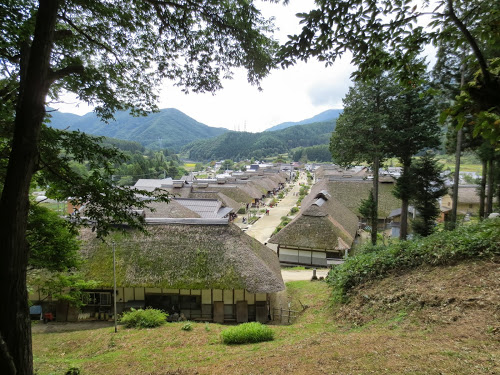 Saw the link for this posted by Eden Law to the JETAA Oceania Facebook group. Here’s a sample post:
Saw the link for this posted by Eden Law to the JETAA Oceania Facebook group. Here’s a sample post:
http://fukushimalive.blogspot.jp
“This blog Fukushima Live collects stories from people living in Fukushima Prefecture”
Hi everyone, my name is William. I’m one of the new CIRs here in Fukushima Prefecture, and am taking over for Lachie Tranter in the International Affairs Division. Lachie has kindly allowed me to continue his Fukushima Live blog. I hope to be able to continue to share with you all life in Fukushima, the challenges people here are facing, and many of the wonderful attractions the prefecture has to offer.
Recently I had the opportunity to travel around the Aizu Region here in Fukushima Prefecture. Aizu, the westernmost region of the three regions in Fukushima, is known for its rich history and sake-brewing industry.
The highlight of the trip was visting Ōuchi-juku. Located in the mountains of Minami-Aizu, Ōuchi-juku was a post town during Japan’s Edo period (1603 – 1868). It is famous for the traditional thatched buildings that line its main street, allowing visitors to experience the atmosphere of the Edo period here in modern day Japan.
JQ Magazine Seeks Writers for Fall 2013!
As we head into fall, JETAA New York’s JQ magazine continues to provide content with an ever-expanding array of articles, interviews and features (see our recent stories here). We’re now looking for new writers, including recent returnees and JET vets, from all JETAA chapters worldwide for posting stories via our host at the global JET alumni resource site JETwit.com. (Scribes are also encouraged to join the JET Alumni Writers group on LinkedIn.)
Below are story ideas grouped by JET participants and alumni (JET World) and those more on Japanese culture (Japan World). And if you’re a JET or JETWit contributor from anywhere in the world with a story idea of your own, let us know!
Click “Read More” below for our fall 2013 ideas pitch package, and contact JQ editor Justin Tedaldi (magazine [at] jetaany [dot] org) to sign up for stories.
Now, JQ is looking for additional help behind the scenes! Our editor (celebrating his fifth anniversary at the helm in November) is seeking a capable assistant to help with the posting, social media sharing and story assigning across all JETAA chapters. If you’re a wiz with WordPress, Facebook and Twitter, and enjoy all forms of Japanese arts, events and media, reach out to Justin. Thanks and yoroshiku!
RocketNews24: Scowling mascot brings a little fame to Japan’s least popular prefecture
Michelle Lynn Dinh (Shimane-ken, Chibu-mura, 2010–13) is an editor and writer for RocketNews24, a Japan-based site dedicated to bringing fun and quirky news from Asia to English speaking audiences.
Shimane Prefecture, ever heard of it? If your answer is a resounding “no,” you’re not alone. The oddly shaped prefecture stretching along the western coast of Japan is barely known within its own country, let alone abroad. But one disgruntled mascot is out to bring Shimane’s shortcomings to light, making fun of the prefecture’s lack of popularity and population, and giving the area a little boost in positive publicity online.
For the 95 percent of you who don’t know, Shimane is a prefecture in the Chugoku region of Japan. Its claim to fame is having the most elderly people of any other prefecture and the most centenarians. Year after year, Shimane battles it out with neighboring Tottori for the title of “least populated prefecture” and has repeatedly landed itself at the very bottom of lists ranking areas by popularity.
Return On JET-vestment: “This is Fukushima” Calendar 2014 Fundraiser
Thanks to Ryan McDonald (Fukushima-ken, 2002-05) for sharing the below. Another great example of Return On JET-vestment:
Last year, I and two other ex-JETs, created a calendar called This Is Fukushima. We paid for it ourselves and took donations from other ALTs in Fukushima. We made 2,500 copies and sent them around the world to the media, government officials, and even royalty. The goal was to show that Fukushima is more than a reactor. There is no Fukushima disaster, but there was a disaster in Fukushima. Too many people hear the word Fukushima and think it’s only a nuclear reactor.
This year the theme will be people and interesting places. We already have a few people in mind that have and are continuing to help Fukushima. We are also going to have more photos of some of our unique festivals. We want to print 4,000 this time and have a larger version with one month per page.
There’s no question as to whether or not we can do it. We did already and can do it again. The only question is can we raise enough money to make it bigger and better. Any money raised over the goal will go to printing more calendars.
If you would like to donate, please go to GoFundMe.com
You can also look at some photos of Fukushima at http://www.ThisIsFukushima.org
- Ryan McDonald (USA)- (Fukushima-ken, 2002-05)
- Paul Sprigg (CA)– (Fukushima-ken, 2005–10)
- Henare Akurangi (NZ) – (Fukushima-ken, 2007–11)
New Fukushima JETs make the local newspaper
Just saw this posted to the JETAA New South Wales Facebook group which was re-posted from the Fukushima ALTs Facebook group.
“New JET members are in today’s newspaper (Fukushima Minpo). It says 43 new JET members visited the governor and expressed their hopes.”
Local Japan: Ehime JET alums to publish illustrated book of their 88 temple pilgrimage
Maryland-based Ehime-ken JET alums Elayna Snider and Chelsea Reidy have put together an illustrated book of their “88 temple pilgrimage” by bicycle in Shikoku. They now have a Kickstarter page to help them raise funds to publish it and a wonderful video that explains what this is all about. Definitely worth a look. It’s hard to do justice in my own words, so click the link and watch and read for yourself:
http://www.kickstarter.com/projects/1042996508/temple-by-temple
Excerpts from the Kickstarter site:
There are 88 temples on Japan’s 88 temple pilgrimage. With two bicycles, a tent, notebooks and pens, plus a Rolleiflex, we will go to all of them. While we travel the 900-mile route, we’ll be collecting the materials needed to make 88 hand-bound versions of our illustrated book, Temple by Temple.
Elayna does the art, Chelsea does the words. A children’s book? It can be. A coffee table book? Sure. A book you have around and pick up from time to time? Yes! The idea and project did not come from any prescribed place of “Let’s make a kids book.” We are two people with varying ideas and skills and we combined them to make a book that describes the route, the temples, and this 1,200 year old pilgrimage which draws people of all different faiths and from all over the world.
JETs in the News: Sankei Shimbun profiles Fukushima JET, quotes JETAANY President
The following article recently appeared in Japanese in the Sankei Shimbun. Very special thanks to CLAIR NY’s Matt Gillam for providing a quick and functional summary/translation upon request. Scroll further down for the Japanese version.
“Fostering Japan Evangelist”
http://sankei.jp.msn.com/world/news/130807/amr13080716050007-n1.htm
Article by Hajime Matsuura
Sankei Shimbun, August 7, 2013
On his way home the other day, Jaime Vogenitz, originally from Philadelphia, had an experience unthinkable in the US. A woman with two children waved to him, gave him some deep-fried foods, and told him to have them for dinner. “I was deeply moved. She must have known I am teaching here,” he said. He arrived in Minamisoma (Fukushima Prefecture) last year in July and is teaching in the elementary school there.
He teaches 3 or 4 classes a day, about 500 or 600 kids altogether, and tries to find ways to make learning English fun for them. During his free time he also sits in on the kids’ Japanese language (kokugo) classes to improve his own Japanese ability.
Vogenitz is in Japan on the JET Program, which is a joint undertaking between local authorities and the Ministry of Foreign Affairs and other agencies. It brings Assistant Language Teachers, Coordinators for International Relations, & Sports Exchange Advisors from mainly English-speaking countries to Japan. Around 90 percent of these are language teachers like Vogenitz, and about half of those are from the US.
There was a blank space in heavily damaged Minamisoma after 3.11, but last year Vogenitz overcame stiff 1-in-5 odds to be accepted into the Program and became the first person to fill the recreated position.
Even though Minamisoma is so close to the Fukushima No. 1 Reactor and the situation there is known even in America, Vogenitz was happy to be able to be able to come here. Having studied Japanese himself he says he “wanted to share the joy of learning a new language with kids in the affected areas.”
Just last month, on July 26th, a send-off party was held at the Ambassador’s Residence in New York for the 95 new JETs who would leave New York the next morning for Japan. There was a mixture of anxiety and expectation, but everyone shared the same feeling of wanting to “become ‘cultural ambassadors’ after returning to the States to introduce your knowledge of and great experiences in Japan to people here in the US” (Monica Yuki, JETAANY President).
Begun in 1987, the JET Program has brought over 55,000 people to Japan. About half the participants from the US have joined alumni associations there after returning home, which serve as “places for people who love Japan to get together”, and where they serve as interviewers for new JET applicants. And while there was a lot of fundraising and volunteer activity in the US after 3.11, many JET alumni were out in front leading these efforts.
This network is also “a market to cultivate supporters of the US-Japan relationship.” JET alumni who return to the States help form the backbone of society, and are active in a wide variety of fields from foreign officers and academics to journalists, and some have even run for Congress. They conceal the potential to become the wellspring of Japan’s soft power.
The JET Program’s continued existence was in danger from the DPJ government’s ‘jigyo shiwake’ review process. But putting aside evaluations of its management, the review failed to recognize the Program’s “return on investment” and “cost-benefit analysis” in terms of foreign relations and cultural exchange value.
Vogenitz says, “I am grateful to have such meaningful work,” and he hopes to study management after he returns to the States. In the meantime, his father, who supported his going to Minamisoma, is planning to visit him there next summer.
******************
「日本伝道師」育てる外国青年の招致事業 ソフトパワーの源泉に
2013.8.7 16:02
米東部フィラデルフィア市出身で日本に滞在中のジェイミー・ボゲニッツさん(27)が、帰宅途中、米国では考えられない体験をした。
子供を2人連れた女性から通りすがりに手招きされたので、近寄ってみたところ、女性は買い物袋から揚げ物の総菜を取り出した。「晩ご飯に食べなさいよ」
「感激しました。僕が地元で教えているのを知っていたのでしょう」と語るボゲニッツさんは、福島県南相馬市に住む英語教師だ。昨年7月に来日し、地元の小学校で教えている。
日課はなかなか忙しい。小学生500~600人を相手に、毎日3、4コマほどの授業で教壇に立つ。授業にゲームの要素を取り込むなど、教え方にいろいろと工夫を凝らしている。空いた時間は、小学生と一緒に国語の授業を受けて日本語力を磨き、放課後は柔道を習っているという。
ボゲニッツさんは、日本の地方自治体などが共催する外国青年招致事業、JETプログラムの一環で来日した。外務省などの協力を得て、JETプログラムは主に英語圏から外国語指導助手、国際交流員、スポーツ国際交流員を日本に招致する。9割方がボゲニッツさんのような外国語指導助手で、その半数ほどが米国人という。
JETプログラムでは東日本大震災を機に、津波で大きな被害を受けた南相馬市の枠が一時的に空白となった。2012年から復活し、合格率5倍の難関を突破したボゲニッツさんは再開第1号として指名された。
福島第1原発の近隣だったこともあり、米国でも南相馬市の被災状況は知られていたが、意気に感じたボゲニッツさんは指名を喜んだ。学生時代に日本語を学んでいたボゲニッツさんは「新しい言語を覚える喜びを被災地の子供たちと分かち合いたかった」と言う。
7月26日、ニューヨークの日本総領事館では、JETプログラム参加者として翌日に日本へ出立する95人を招待した壮行会が開かれた。若者らの表情には、期待と不安が入り交じっていたが、共通するのは「帰国後には『文化大使』として日本に関する知識と良き体験を母国に紹介する」(ニューヨークJET同窓会代表のモニカ・ユキさん)点にある。
1987年に始まったプログラムは、約5万5千人の外国人を採用してきた実績がある。米国の場合、およそ半数のJET出身者が「親日家交流の場」である同窓会に登録し、新しい応募者の面接官役も務める。東日本大震災に関連した募金・ボランティア活動は米国でも活発だったが、多くのJET出身者が旗振り役だった。
そのネットワークは「日本外交の支援者を開拓する市場」でもある。米国に戻ったJET出身者は社会の中堅として、外交官、学者からジャーナリストまで、幅広い職業で活躍しており、米議会選に立候補する者も出てきた。日本のソフトパワーの源泉となる可能性を秘めているのだ。
JETプログラムは民主党政権下の事業仕分けで存続の危機にひんしたことがある。マネジメントへの評価はさておき、外交・文化交流における“投資効率”や“費用・便益分析”を事業仕分けは見落とした。
「やりがいのある仕事を得て感謝しています」。帰米後に経営大学院に通い、ビジネスマンとなる将来図を描くボゲニッツさんの声が受話器の向こうで弾んでいた。南相馬市行きを応援してくれた父は、来年夏に初来日を予定している。(ニューヨーク駐在編集委員・松浦肇)
Books: An English Language Guide to Crafting in Tokyo
 Interview by Rose Symotiuk (Hokkaido 2003-2005) with Angela Salisbury, author of the Tokyo Craft Guide:
Interview by Rose Symotiuk (Hokkaido 2003-2005) with Angela Salisbury, author of the Tokyo Craft Guide:
As a JET, I keep track of my friends from my Japan days on Facebook. I started seeing posts by my fellow JETs for this cool e-book about crafting in Tokyo. Imagine my surprise when I realized that one of the authors, Angela Salisbury, was an old friend from high school!
I reached out to her to find out more about the book, crafting in Japan, and the JET crafting scene….
Rose: So, how long have you lived in Japan?
Angela: 3 years
Rose: Why did you move to Japan?
Angela: Adventure! The real answer? My husband’s job needed him in Asia, and we decided Tokyo was the place for us.
Rose: Is there an expat crafting scene in Tokyo? If so, can you tell me a little bit about it? Read More
JET alum helps produce “The Birth of Sake” documentary

Tara Hohenberger, who first fell in love with saké and the Japanese culinary world as an ALT in Nara (2001-2003) wrote to us about a film project she is helping produce. The documentary The Birth of Saké profiles the production seasons and lives of the workers at Tedorigawa, a fifth-generation, family-owned sake brewery in Ishikawa, Japan. Tedorigawa has been producing some of the world’s top award winning sakés since 1870 and still utilizes very traditional brewing methods.
Tara is working on the project with filmmaker Erik Shirai, who was a cinematographer on The Travel Channel’s No Reservations’ with Anthony Bourdain. The crew was first invited to the brewery in August of 2012 and was intrigued by the intense and relatively unknown process (even within Japan) of traditional saké making. Led by Brewmaster Teruyuki Yamamoto, the team of brewers is made up mostly of migrant farmers who grow rice in the summers and return to the brewery in late October to begin an intense six-month period of saké production. They will live under the same roof and eat three meals a day together. At the most intense time, when they brew the ultra-premium Daiginjyo variety they will barely have time to sleep.
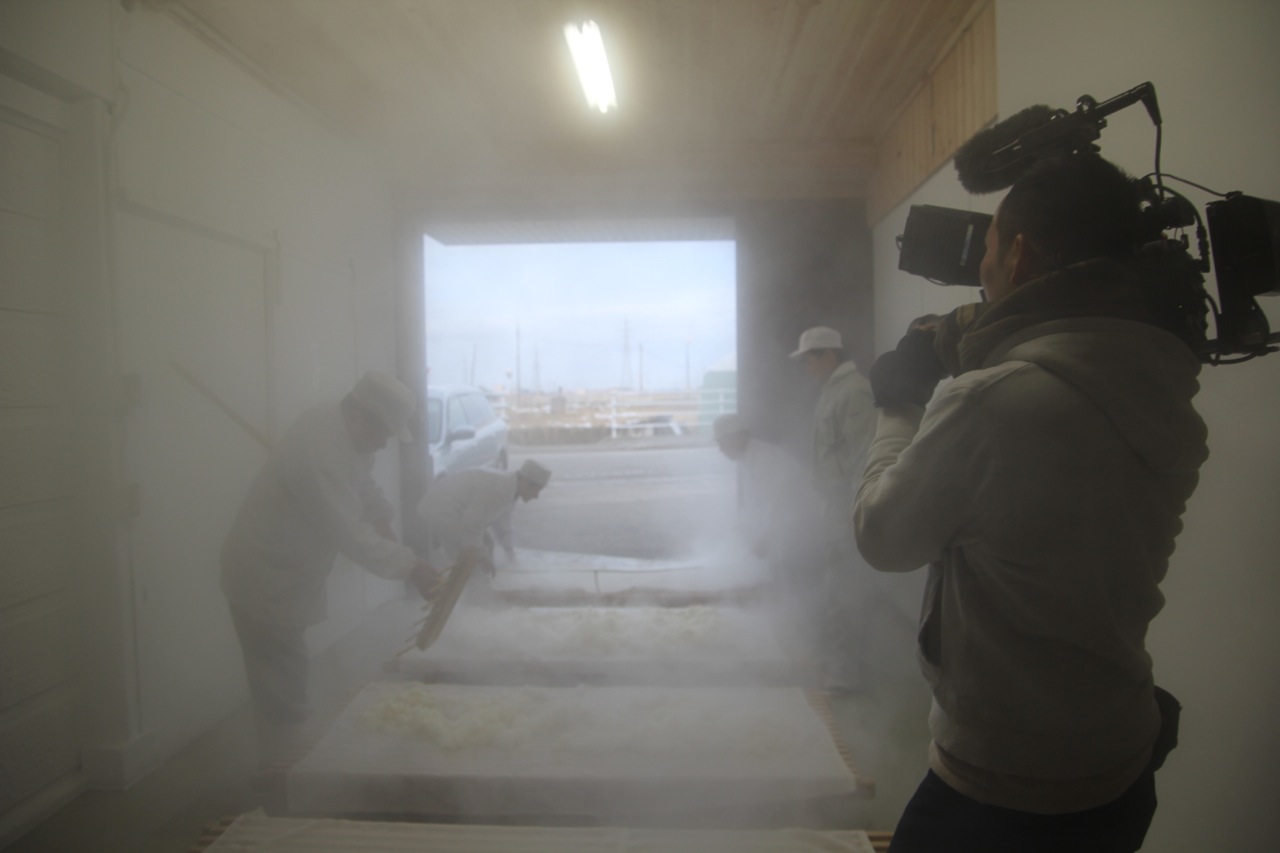 In January 2013, they returned to Ishikawa and were granted permission to spend several weeks living amongst the workers at the brewery. It allowed them a rare window into a cast of vibrant and dynamic characters and fueled their interest in painting a deeper portrait of the people behind the product. Shirai’s film captures this little understood world with his signature lush visual aesthetics in the stillness of winter in northern Japan.
In January 2013, they returned to Ishikawa and were granted permission to spend several weeks living amongst the workers at the brewery. It allowed them a rare window into a cast of vibrant and dynamic characters and fueled their interest in painting a deeper portrait of the people behind the product. Shirai’s film captures this little understood world with his signature lush visual aesthetics in the stillness of winter in northern Japan.
On July 9, they launched a Kickstarter campaign running through September 2, 2013, to complete the project. They hope to raise $50,000, which will allow a visit to film the Brewmaster in his hometown of Noto, Japan to illustrate the contrast of the intense life he leads inside the brewery for six months a year, with that of his land, his rice fields, his wife, children and his grandchildren. The film will also capture the critical moment when the workers return to the brewery to begin the production cycle again. Funding will also cover editing, musical composition, licensing, equipment rentals and other post-production costs.

You can view the trailer on The Birth of Saké’s Kickstarter page at
http://www.kickstarter.com/projects/1802764272/the-birth-of-sake
The filmmakers greatly appreciate your help in spreading the word about the film. Follow them at facebook.com/birthofsake + on Twitter: @iamwhatieatTV
News agency Kyodo News has recently been publishing monthly articles written by JET alumni who were appointed in rural areas of Japan, as part of promotion for the JET Programme. Below is the English version of the column from June 2013. Posted by Celine Castex (Chiba-ken, 2006-11), currently programme coordinator at CLAIR Tokyo.
*******

“The four years I spent in Japan were some of the most significant years of my life; years I would not trade for anything in this world.”
Nadya Dee (Kagoshima-ken, Hioki-shi, 2007-11) is a writer, editor and blogger born and raised in the city of Kingston, Jamaica. With a Bachelors degree in English Literature from The University of the West Indies, she joined the JET Programme in 2007 and spent four years living and teaching English in Kagoshima, Japan. She currently works as an independent copywriter and her professional website can be found at http://nadyadee.wordpress.com. As a writer, she intends to write books and collections of short stories which explore the evolution of human consciousness. Through her international experiences she hopes to create written works that speak to the heart and soul of all mankind.
Ichi go Ichi e 一期一会: A Once in a Lifetime Opportunity
Before going to Japan in 2007, I knew nothing about Kyushu let alone Kagoshima. I searched the internet but could only find a little information about the place that I was going to live for a year. I learnt about the active volcano Sakurajima and the “Last True Samurai” Saigo Takamori but I never expected to have such an amazing experience and I never thought that, half way across the world, I would find my second home.
I joined the JET Programme to broaden my international experience with the intention of spending just one year. I left my homeland, Jamaica, and went to Japan as an Assistant Language Teacher to teach English as an alternate form of communication. I went as an ambassador, to increase global awareness and foster a positive relationship between Japan and Jamaica; two countries so far apart but with such similarities. While living in the town of Ijuin, in a city called Hioki on the Satsuma Peninsula in Kagoshima Prefecture, I taught Bob Marley songs, learnt Kagoshima-ben, played taiko, danced in a mud festival, wrote haiku and made great friends who I now consider a part of my extended family.
As a Prefectural ALT I taught at a technical high school, an agricultural high school, a special needs school and two different high schools in and around Hioki and Ichiki-Kushikino City. My responsibilities included lesson planning, team-teaching in Oral Communication classes, motivating students to practice English, editing essays and compositions, helping students to prepare for skit and speech competitions, providing pronunciation and interview preparation support as well as promoting international awareness within Japanese society. I always ensured that all my students learnt about Jamaican food, music and culture in my self-introduction classes.
After a year of adjusting to life in Japan I got the rare opportunity to perform taiko with the ‘Fukiage Seishou Daiko Group’ in four festivals throughout the rural area of Hioki City. In the following years I went on to teach reggae dances to my Japanese friends and we also performed in various shows and matsuri in and around Kagoshima City. Read More
Sister City Ties Ep #1: ALTs of the JET Program
Eliot Honda (Ehime-ken, 2009-2012) has started a unique video series on Sister City Ties in which he interviews current and former JETs:
BBC: Fukushima schools rebuild after disaster
It would be interesting to hear any comments or perspectives from Fukushima JETs or alums about what they describe in this BBC article. (Thanks to Eden Law of JETAA New South Wales for posting it to their Facebook group.)
Fukushima’s Schools Rebuild After Disaster
“How do you re-build an education system destroyed by a disaster? The OECD’s Andreas Schleicher describes the efforts in Japan, two years after the nuclear accident in Fukushima.”
Link to full article: http://www.bbc.co.uk/news/business-21576192
Why is Japanese Food so Delicious?
Posted by Benjamin Martin, a 5th year JET on Kume Island in Okinawa, publisher of the blog MoreThingsJapanese.com and author of the award-winning YA fantasy series Samurai Awakening (Tuttle).
It’s no secret that Japanese food is popular outside of Japan. Not only is the food in-country highly rated, but there are Japanese restaurants all over the world. A lot of people wonder, why is Japanese food so good? It’s a complex answer. Many will tell you it’s umami, others the care and thought put into food, and yet more that it’s the simplicity of the dishes that highlights natural flavors.
I’m not a food expert, but I think it’s a bit of all the above.
When I lived in the States, I never ate fish. Maybe it was because I lived in the desert and all we got were frozen or river fish. Whatever the reason, I’ve had an aversion to most fish since I was young. Then, 5 years ago, I got dropped on a little island in the Pacific, their second industry being fishing. Their food was fresh, delicious, and amazing.

A week ago I had a shrimp that was still moving a bit. And IT WAS SO GOOD. My family will tell you what large strides my palate has taken over the last five years. So why was that prawn tail I had so much better than any other shrimp I’ve ever had? How did a bit of still moving shrimp overcome 23 years of stubborn dislike?
Simplicity. The shrimp was peeled, and served with a bit of soy sauce. There were no other flavors to get in the way, no cross-contamination from sauce pans, pasta, or other fish.
Umami. The briny flavor combined with the bite of soy and the sweetness of the meat meant create that unique sixth taste that everyone raves about. It’s a balance easily lost when the simplicity is left out.
Quality. Kume Island is known for miso cookies, sugar cane, and white sand beaches, but it’s also home to many kuruma prawn farms. Kuruma Prawns are similar to tiger shrimp, but a slightly different species. They’re the kind of shrimp Jiro’s restaurant used in the documentary Jiro Dreams of Sushi.
So what makes Kume Island’s shrimp so good? Checkout the video below then head over to Kumeguide.com to learn more about Kume Island Prawns.
**Please note: At least 3 shrimp were harmed in the filming of the video and writing of this post. They were delicious.**
JETAA USA Disaster Relief Fund Update – 06.01.13
Jim Gannon (Ehime-ken, 1992-94), Executive Director of the Japan Center for International Exchange (JCIE/USA) and a member of the JETAA USA Disaster Relief Fund Committee, was recently in Tohoku for work and shared the following update regarding one of the projects that JETAA USA helped fund:
Jim says he met with Kodomo no Empowerment Iwate (click here for their Facebook page) and also had a chance to talk with two representatives of the Rikuzentakata Board of Education and learned:
- The BOE and many people in the prefecture see the Manabi-no-heya project we supported as a crucial element of the town’s recovery, and the Ministry of Education has selected it as a model project for introduction around the country.
- They currently have 206 students enrolled in Rikuzentakata alone, and have expanded to Kamaishi, Ofunato, Miyako, and other affected cities, adjusting the program to fit local circumstances.
- The big news they were happy about was that one of the students from the tutoring program was just ranked #1 out of 600 on the Rikuzentakata high school entrance exams.
- The Ministry of Education and private source have provided funding for the project that is many multiples of JETAA USA’s, but the organizers and the city officials all credit JETAA-USA as providing the seed money to help get this off the ground.
Here’s a news video about the project (in Japanese – if someone wants to post a summary in some form that would be great, btw):
Photo #1: From Kodomo no Empowerment’s gathering of their Rikuzentakata program managers (senior tutors), on Saturday. They got together to discuss how to improve the program, discuss student management issues, etc. The fact that they were sacrificing an entire Saturday for this shows just how committed they are. The person standing is Iwate Prefectural University Professor Katsuhiko Yamamoto, who heads Kodomo no Empowerment.
Photo #2: A student named Masako who was a student in the Otsuchi program, which is held in a temporary housing unit. She is showing off her desk where she had been studying English. She just enrolled in Nagoya College of Foreign Languages, an extraordinary triumph for a student from a small town like this. She seems to be taking some time to volunteer now with a development NGO in the Philippines in order to give back and also to brush up her English.



